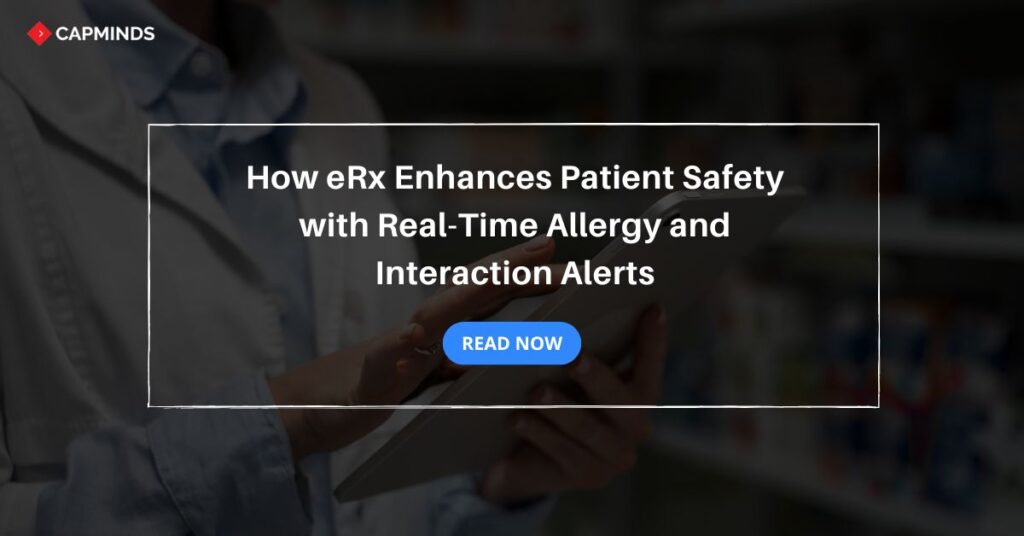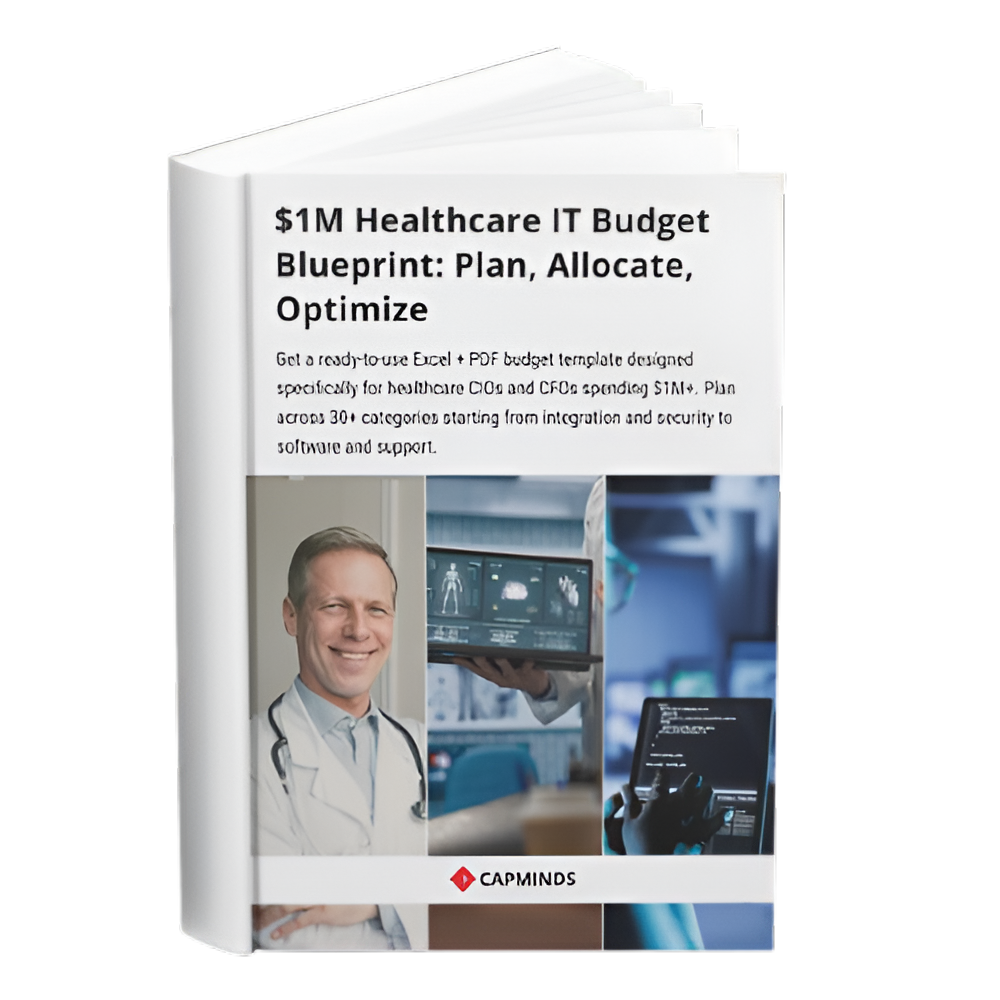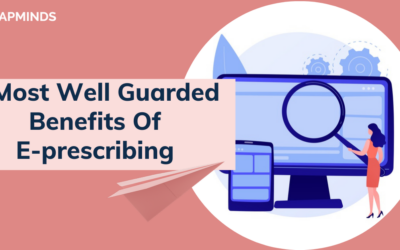How eRx Enhances Patient Safety with Real-Time Allergy and Interaction Alerts
Medication errors remain a significant concern in U.S. healthcare. FDA receives over 100,000 such reports annually. These errors contribute to more than 1.5 million adverse drug events each year. This thus leads to approximately 700,000 emergency department visits and 100,000 hospitalizations.
Electronic prescribing has become a pivotal solution to address these challenges. In this blog post, we have shared the challenges in traditional prescribing methods and how eRx systems tackle their real-time alerts for allergies and drug interactions.
What is Electronic Prescribing?
Electronic Prescribing is a system that allows healthcare providers to generate and transmit prescriptions to pharmacies. The primary aim of this method is to eliminate manual handwritten prescriptions.
Manual handwritten prescriptions have many flaws like illegible handwriting, misinterpretation by pharmacists, medication errors, and more.
Using eRx means providers can improve prescription accuracy, ensure patient safety, and streamline the medication prescribing process. Moreover, this system can integrate with EHR, national drug databases, and pharmacy management systems to allow prescribers to:
- Automatically check for drug interactions
- Allergies
- Contraindications in real-time before issuing a prescription.
Related: Which e-prescribing Service in the USA is Suitable for OpenEMR?
The Common Challenges Associated with Traditional Prescriptions
Traditional prescription methods have been the standard for many years as we all know that. This paper-based prescription has several risks and challenges that compromise patient safety.
1. Illegible Handwriting and Misinterpretation by Pharmacists
- Providers used to write prescriptions faster which often leads to a lack of clarity.
- If the prescriptions are not clear, It will make difficult for pharmacists to understand the medication names, dosages, and instructions.
- For instance, drug names with similar pronunciations like hydroxyzine and hydralazine can create confusion when handwriting is unclear.
- This misinterpretation can cause incorrect drug dispensing, dosing errors, and preventable adverse events.
2. Errors in Dosage, Drug Selection, and Refills
- Manually entering prescriptions increases the possibility of dosing errors like lost decimal points or improper unit conversions which might lead to overdose.
- Patients may obtain the incorrect medication due to identical drug names, packaging, or typing problems.
- Refill mishandling can lead to patients unintentionally discontinuing vital drugs which can cause treatment interruptions and potential health consequences.
3. Lack of Real-Time Access to Patient History
- Providers do not have access to real-time patient history in traditional prescription workflow. Which increases the chance of prescription conflict medication risks.
- Patients who receive care from multiple providers may have fragmented medical records making it difficult to track previous prescriptions, allergies, and drug interactions.
- Without consolidated patient data, clinicians may unintentionally prescribe medications that worsen pre-existing diseases or interact badly with other prescriptions.
4. Dependence on Manual Checks by Pharmacists or Physicians
- Pharmacists and physicians manually review prescriptions for potential drug interactions, allergies, and contraindications
- This thus introduces human error and inconsistencies in the prescribing process.
- Workload and time limits can lead to drug safety warnings being disregarded especially in busy hospital and retail pharmacy settings.
- According to research, gaps in manual verification account for a considerable number of drug errors.
5. Inconsistent Patient Medication History Across Different Providers
- Patients used to visit various providers and specialists and each of them maintains separate medical records that may not be updated in real-time.
- Prescribers may prescribe duplicate or contraindicated prescriptions in the absence of a consistent medication history monitoring system.
- A lack of communication among physicians raises the likelihood of harmful drug interactions, allergic reactions, and treatment inefficiencies.
The Impact of Medication Errors on Patient Safety
Medication errors always pose significant threats to patients’ health and the healthcare system as well. According to the Institute of Medicine of the National Academies, medication errors harm at least 1.5 million people each year in the United States. It might lead to prolonged hospitalizations, increased healthcare costs, and adverse patient outcomes.
Real-World Consequences of Medication Errors
- Giving a penicillin-containing drug to a patient who has a known penicillin allergy can result in a life-threatening anaphylactic reaction.
- Combining two anticoagulants without a thorough risk evaluation can result in severe internal bleeding and hospitalization.
- Prescribing a high dose of insulin to a patient who is currently taking diabetes drugs without first examining their history can lead to serious hypoglycemia.
How eRx Provides a Seamless Solution
To eliminate the manual prescription challenges, eRx brings a comprehensive solution that easily tackles the problems faced by providers and pharmacists. More than this, it will also enable improved prescription accuracy, reduce human errors, and enhance patient safety.
1. Automated Patient History Cross-Checking
- eRx systems can integrate with EHR systems to provide prescribers with instant access to a patient’s comprehensive medication history.
- The system automatically cross-checks new prescriptions against existing medications, known allergies, and underlying health conditions.
- Clinicians can make informed prescribing decisions in real-time by automating these checks.
2. Immediate Notification to Physicians and Pharmacists
- eRx system generates quick notifications for drug allergies, potential interactions, duplicate prescriptions, and contraindications.
- Prescribers can address safety problems before the prescription is delivered to the patient.
- Physicians receive detailed safety recommendations, including alternative medications when a conflict is detected.
- Pharmacists benefit from pre-verified, digitally transmitted prescriptions to reduce the need for manual verification and error-prone transcription.
3. Comprehensive Drug Database Cross-Checking
- eRx systems can easily integrate with FDA-approved drug databases to enable prescribers to screen prescriptions for interactions with thousands of medications automatically.
- The system flags high-risk drug combinations, dosage conflicts, and medications requiring special monitoring.
- This will help providers to avoid preventable adverse drug events.
- Using these large drug interaction databases, eRx offers safer medication administration for patients on complex treatment regimens.
4. AI-Powered Risk Scoring for Drug Combinations
- Advanced eRx platforms use AI to assess patient data and provide risk levels for probable drug interactions.
- AI-powered decision support technologies assist clinicians in assessing the safety of various pharmaceutical regimens to recommend dosage modifications and suggest safer alternatives based on real-time patient data.
- This predictive strategy lowers the likelihood of harmful medication reactions.
5. Interoperability with EHRs and Pharmacies
- eRx solutions function smoothly with EHR platforms, hospital networks, and pharmacy management systems.
- Prescriptions are securely sent straight to pharmacies, eliminating the possibility of handwritten prescriptions or verbal misinterpretation.
- Interoperability improves care coordination, especially for patients with chronic diseases that require long-term pharmaceutical administration.
Related: Healthcare EHR Interoperability in 2025: How to Choose the Right Solution
CapMinds eRx Integration and Customization Services
At CapMinds, we offer advanced eRx integration and customization solutions designed to streamline the prescription workflow for healthcare providers and pharmacists.
By integrating with EHRs, national drug databases, and pharmacy management systems, our e-prescription solutions help providers:
- Automate real-time drug interaction and allergy checks
- Improve prescription accuracy and patient adherence
- Seamless interoperability with EHR and pharmacy systems
- Custom eRx module development and integration
- Ongoing support, updates, and training for healthcare providers
We also develop customized eRx solutions tailored to the unique needs of healthcare organizations, ensuring efficiency, cost-effectiveness, and scalability.
Transform your prescribing workflow with a secure, efficient, and fully integrated eRx solution.
Get in touch today to learn how our customized eRx services can enhance patient safety and improve your practice’s efficiency!



